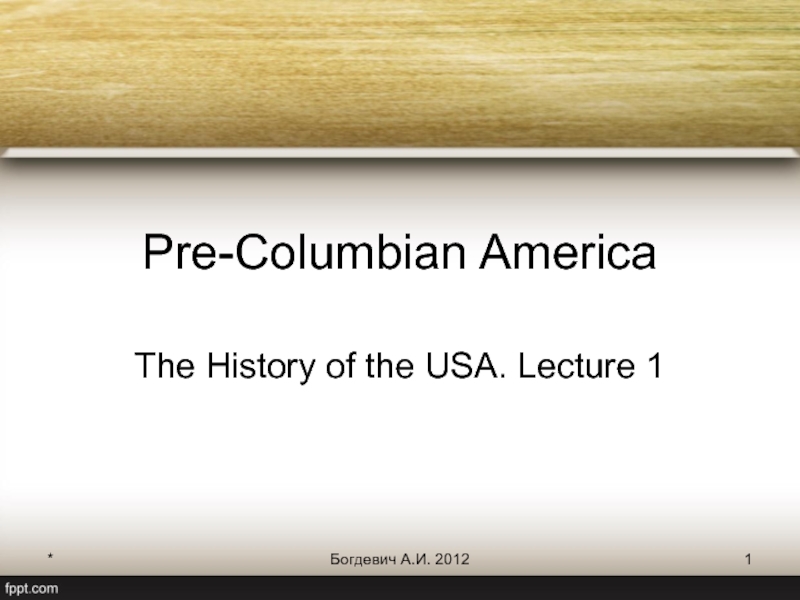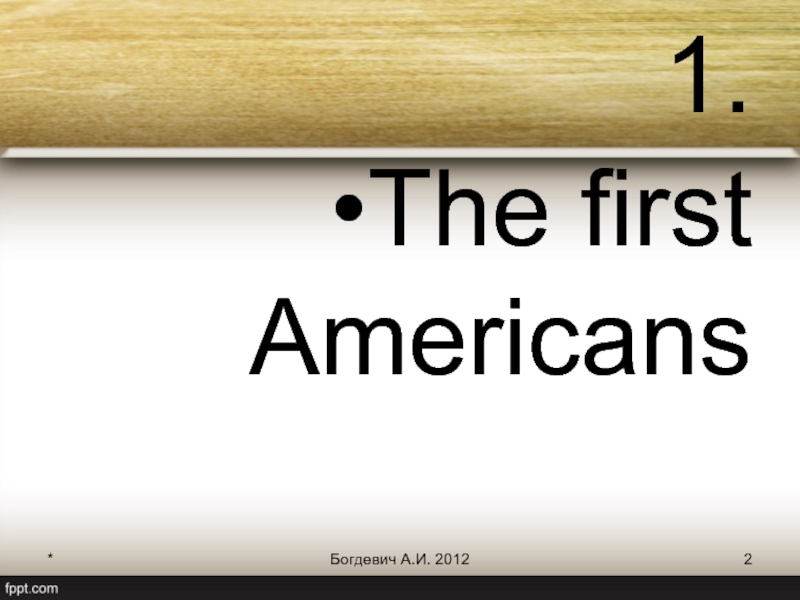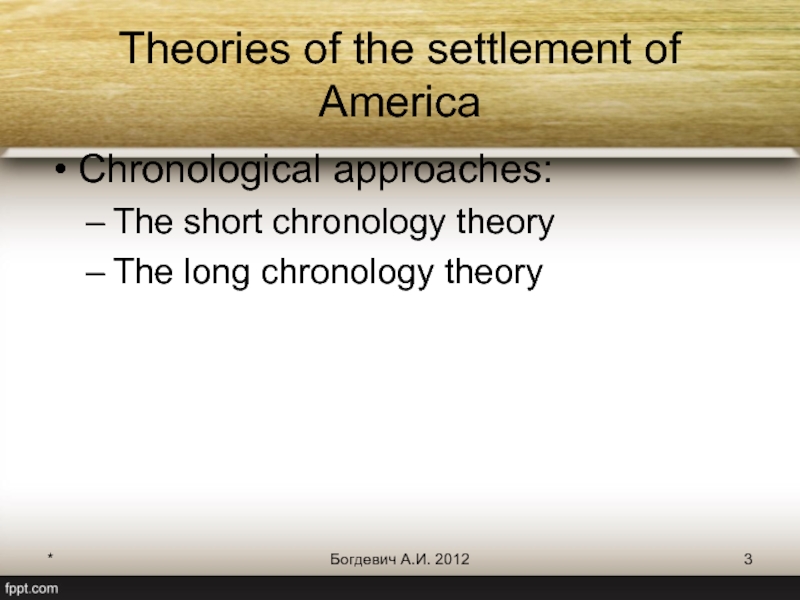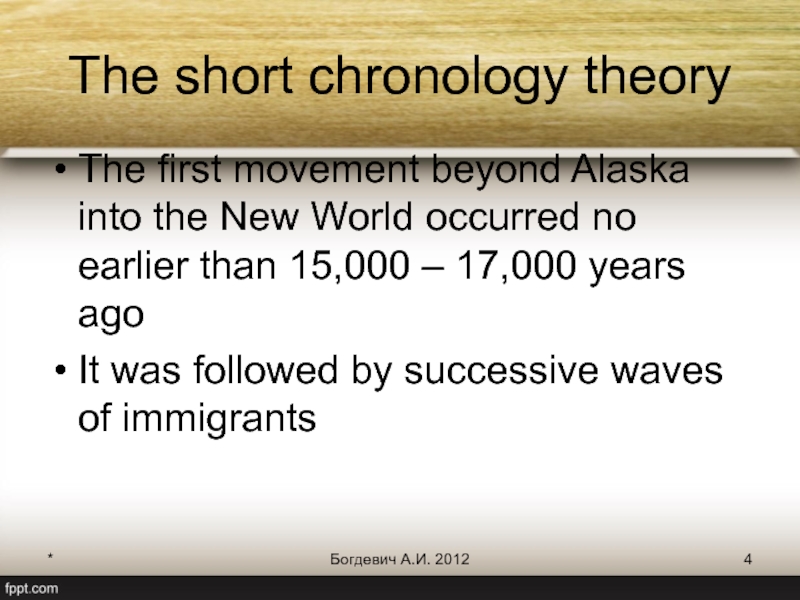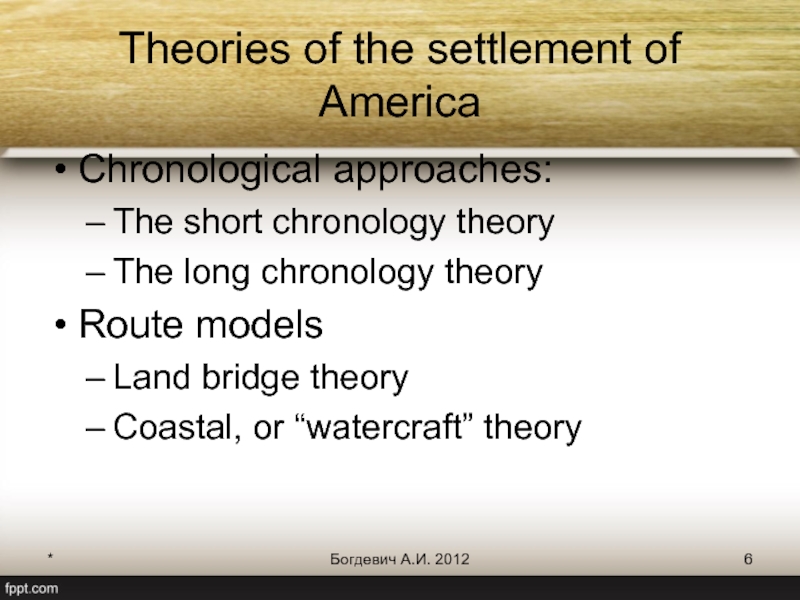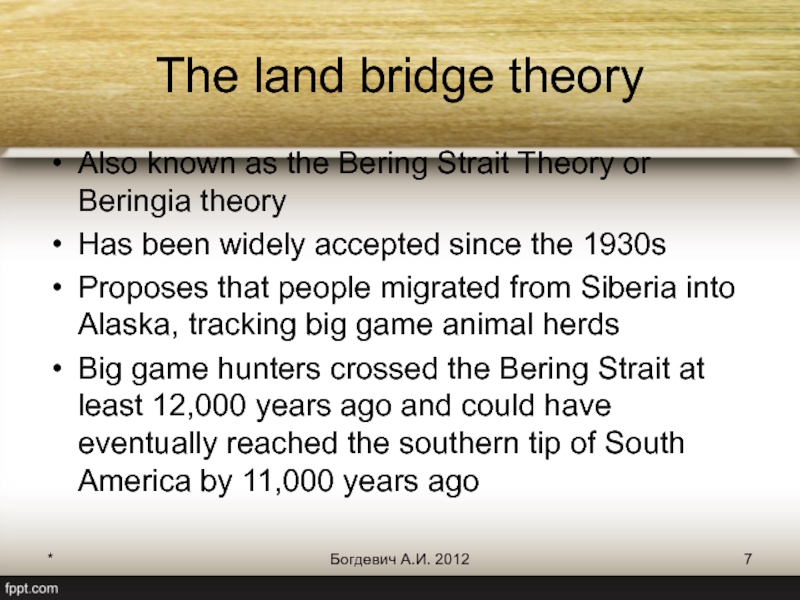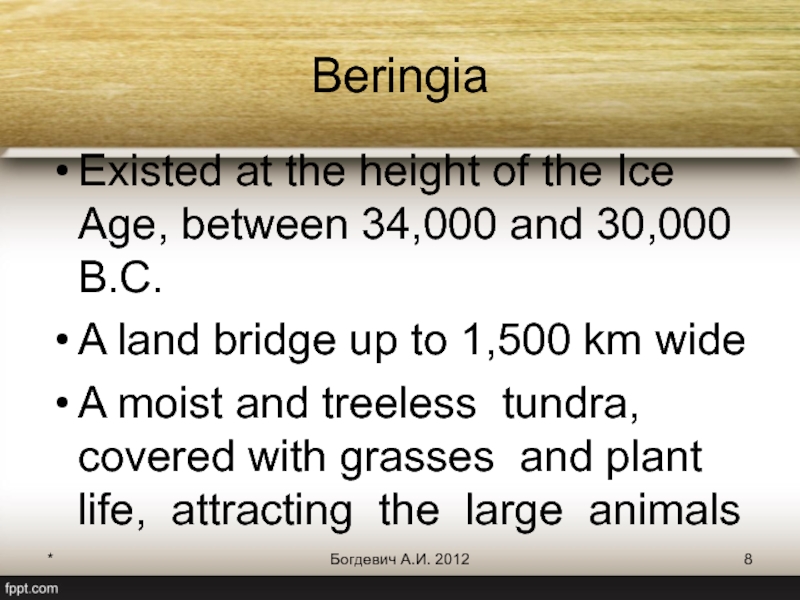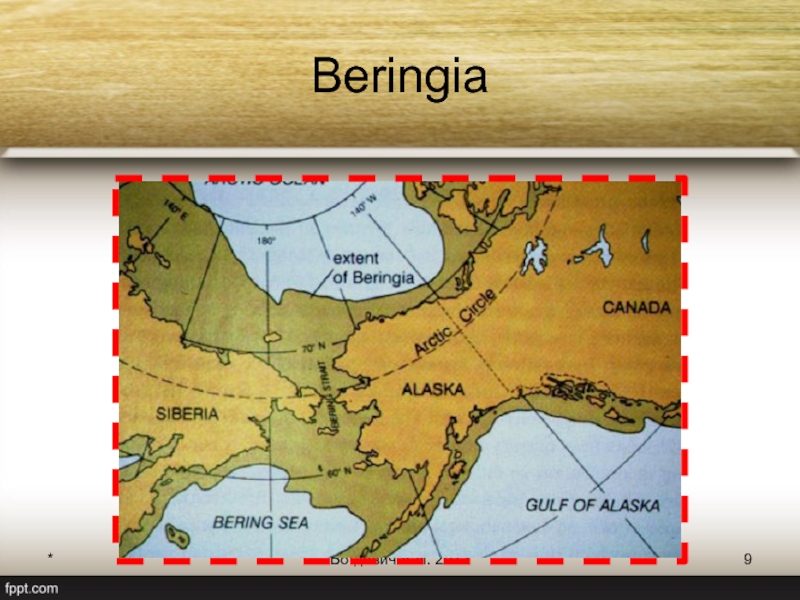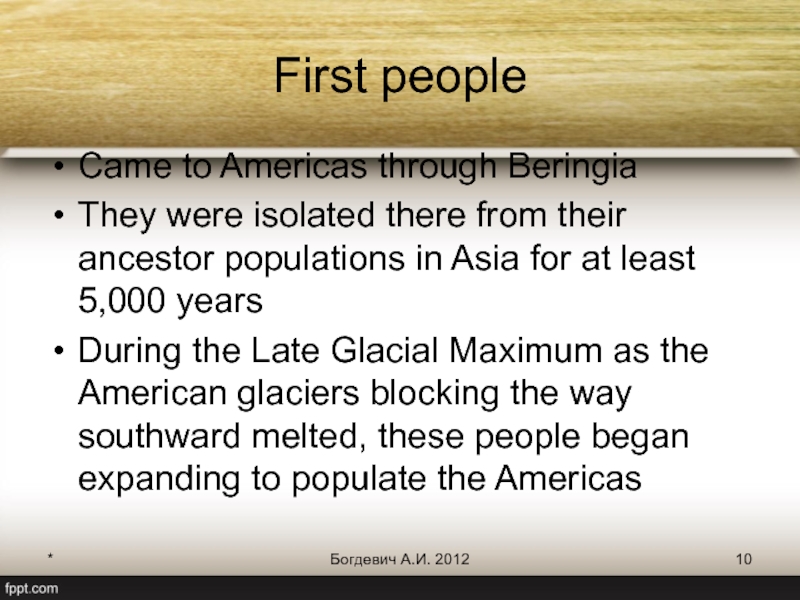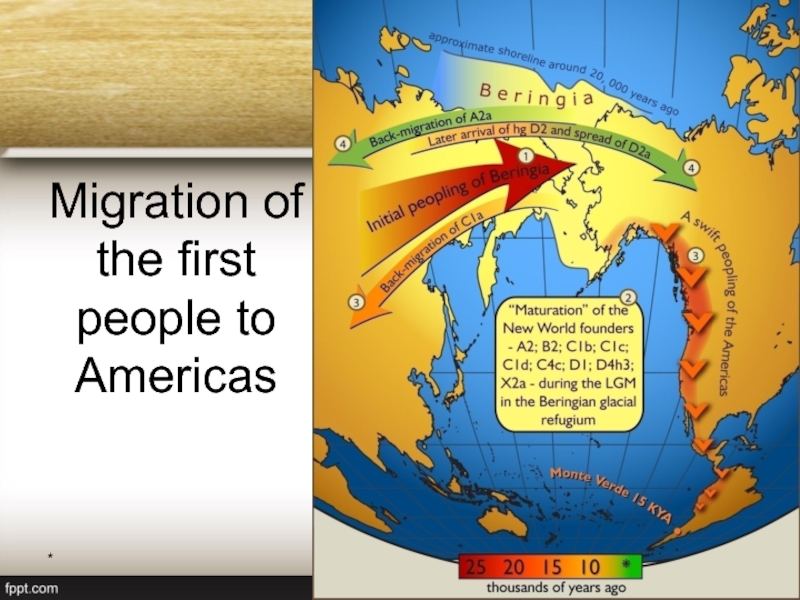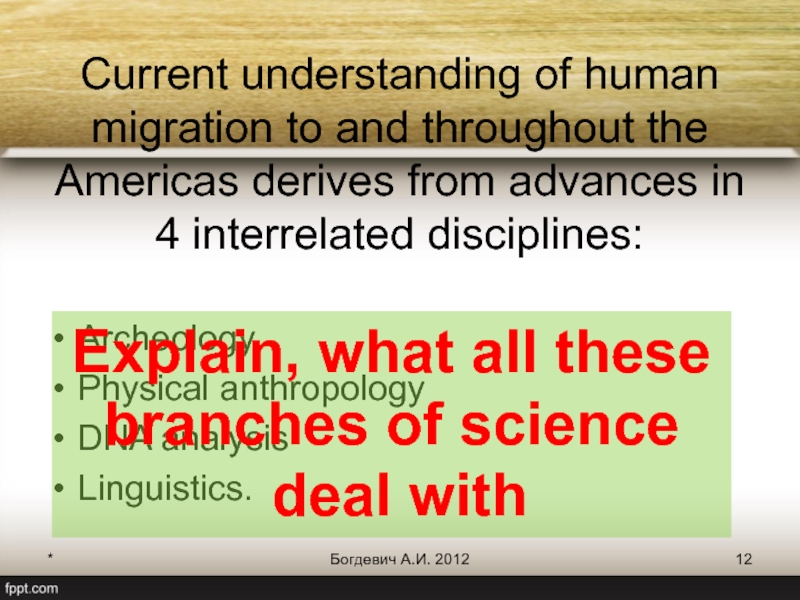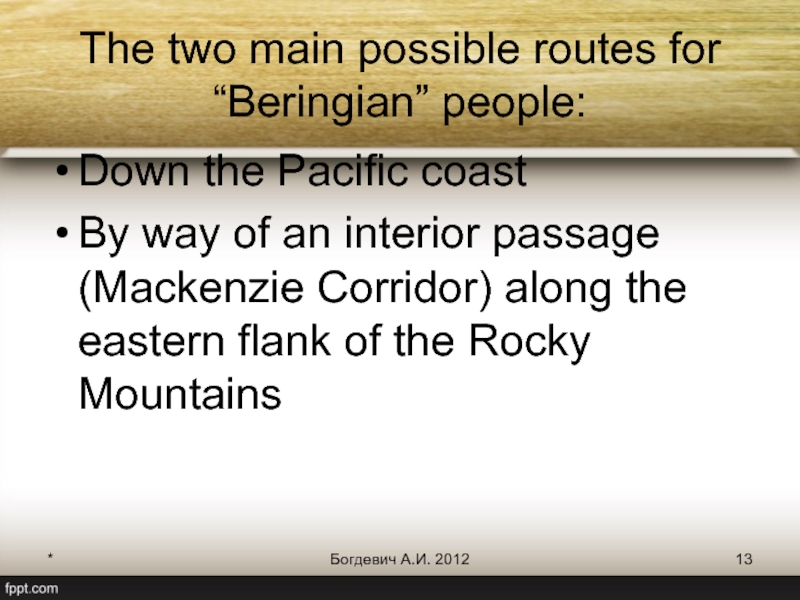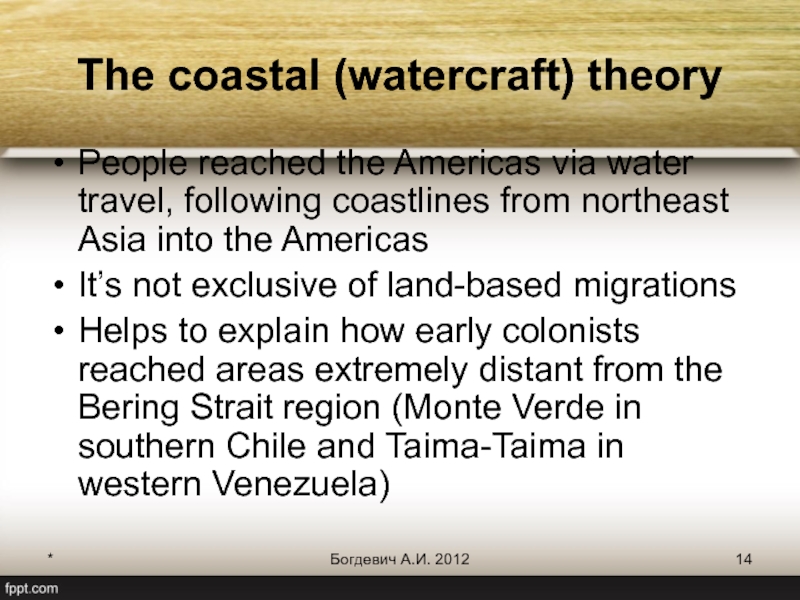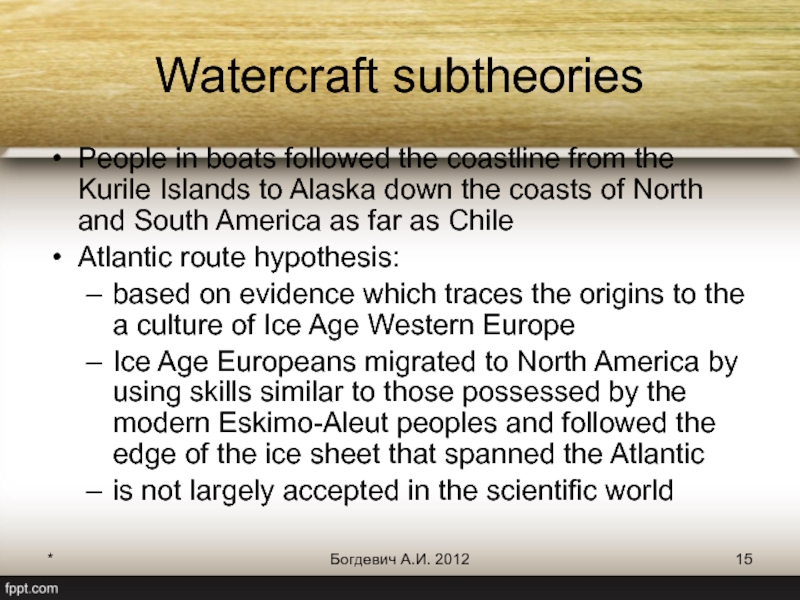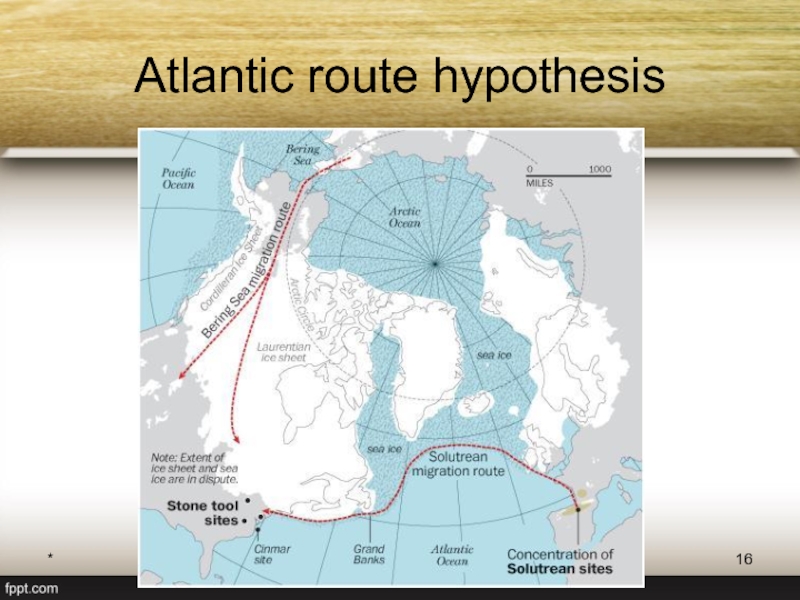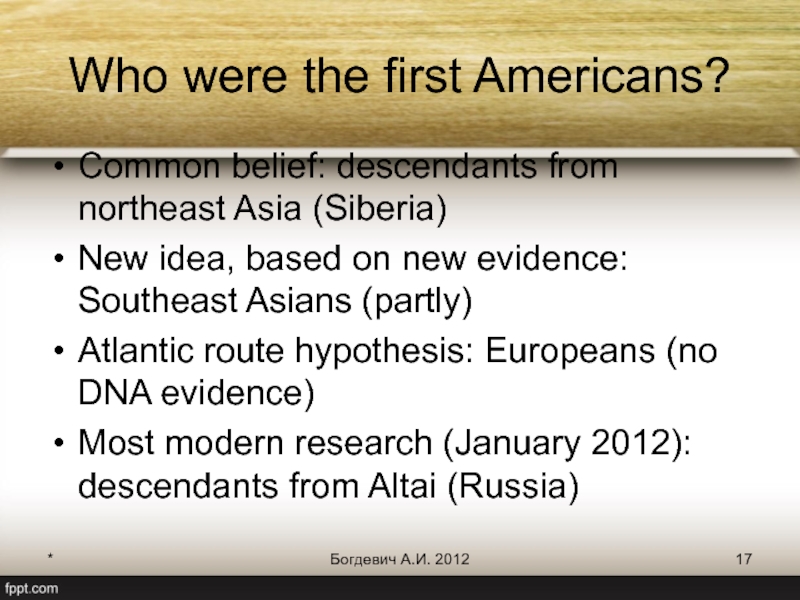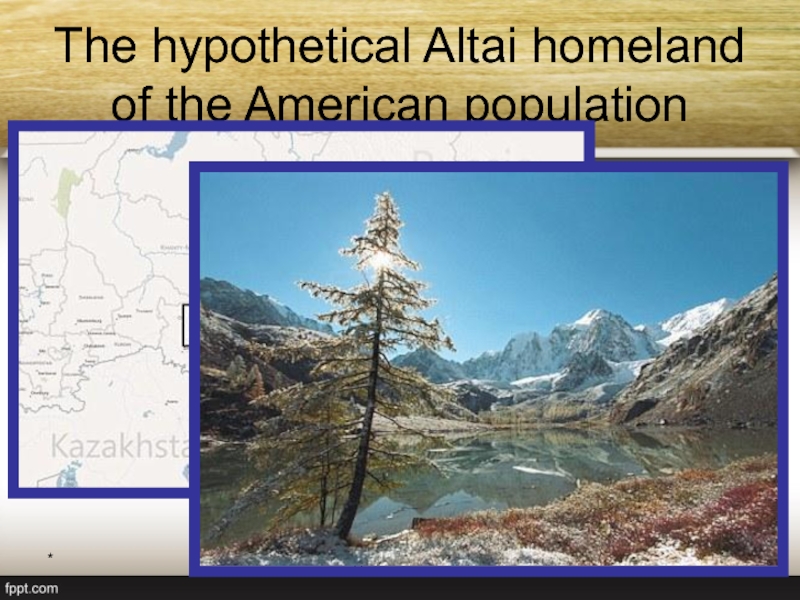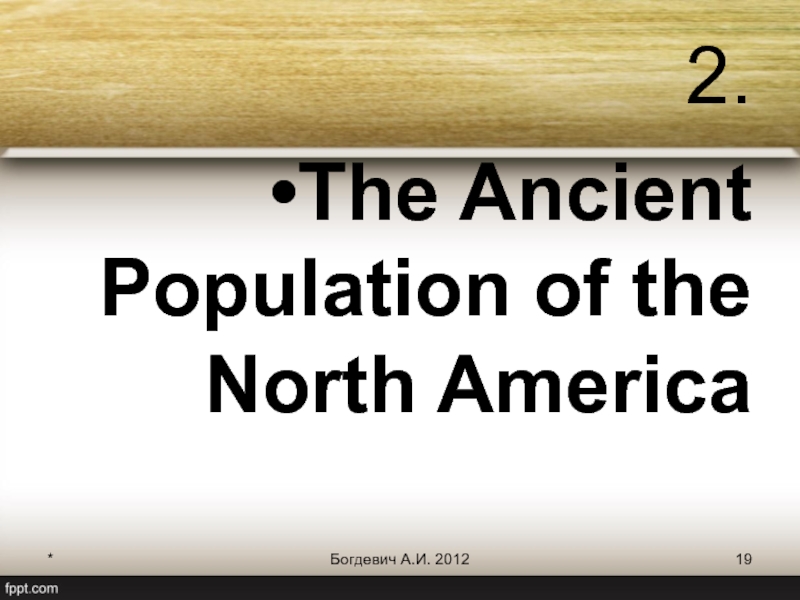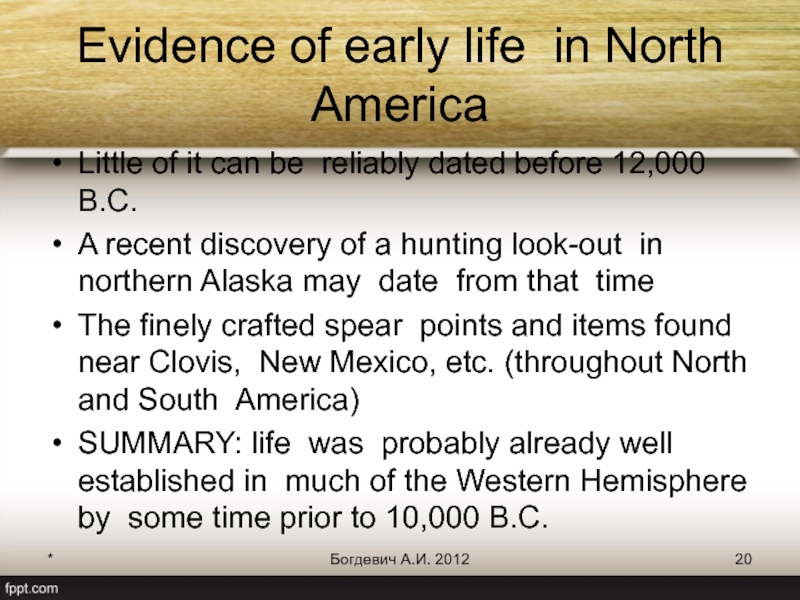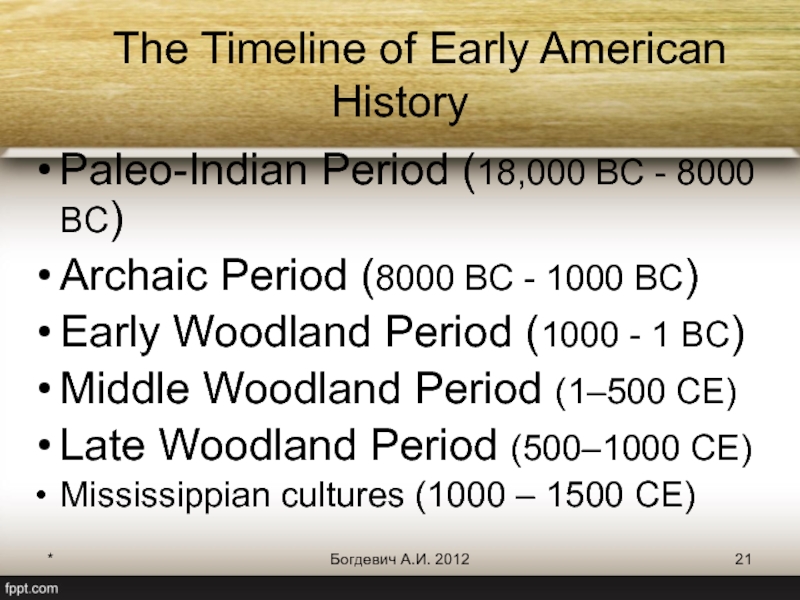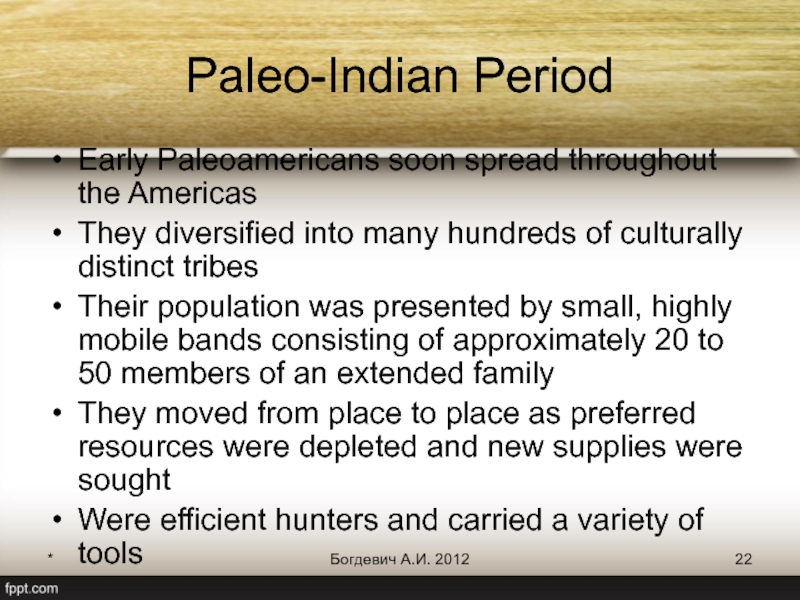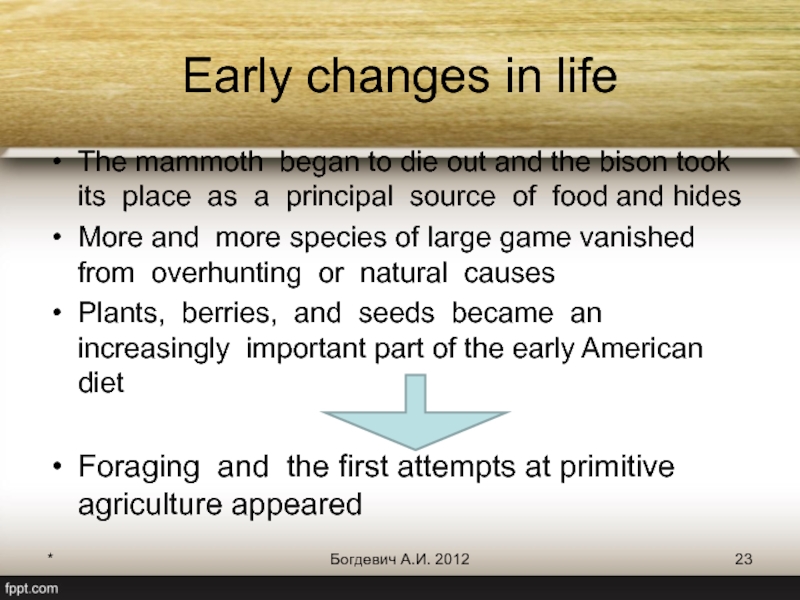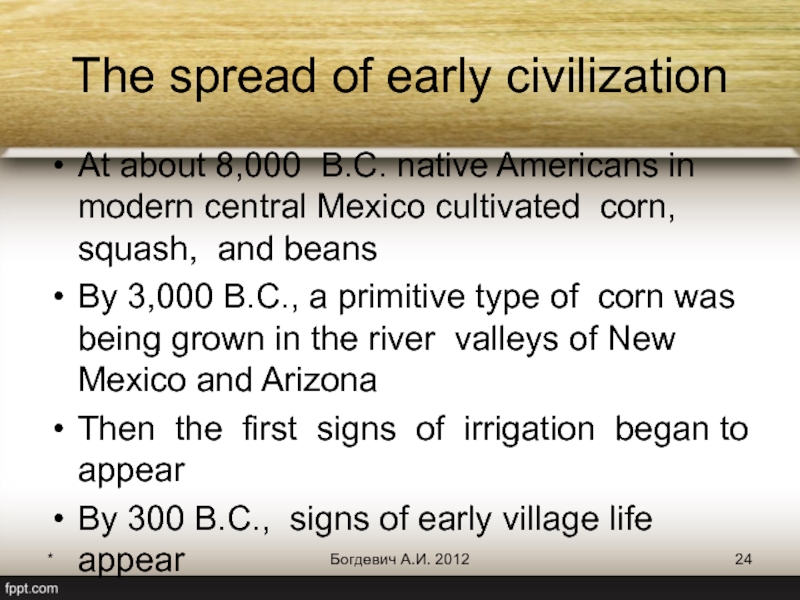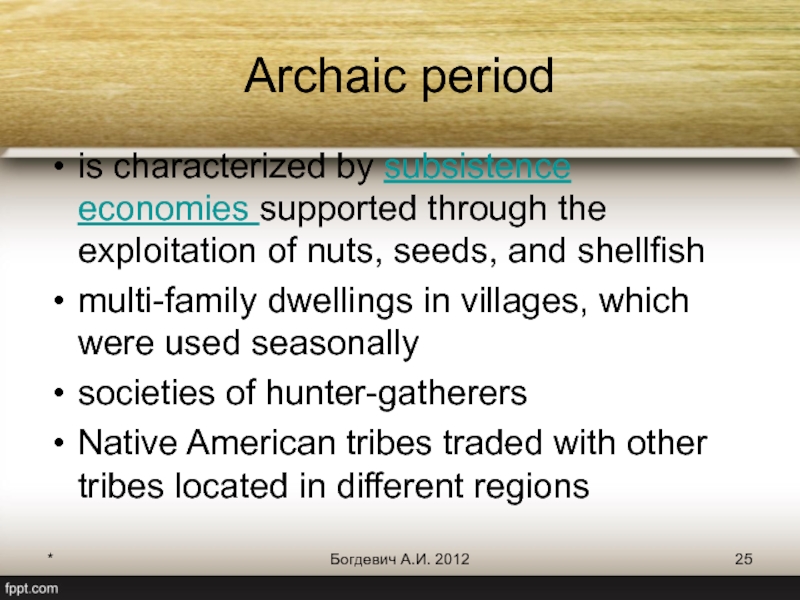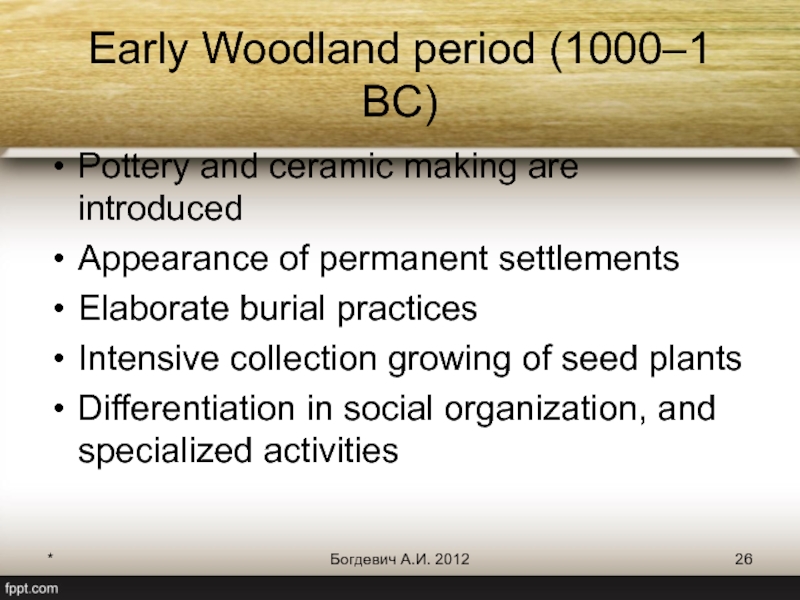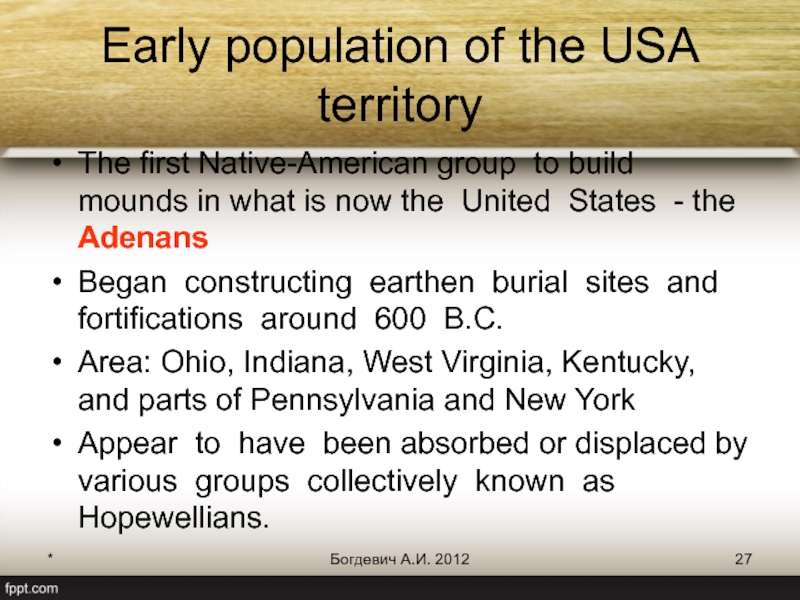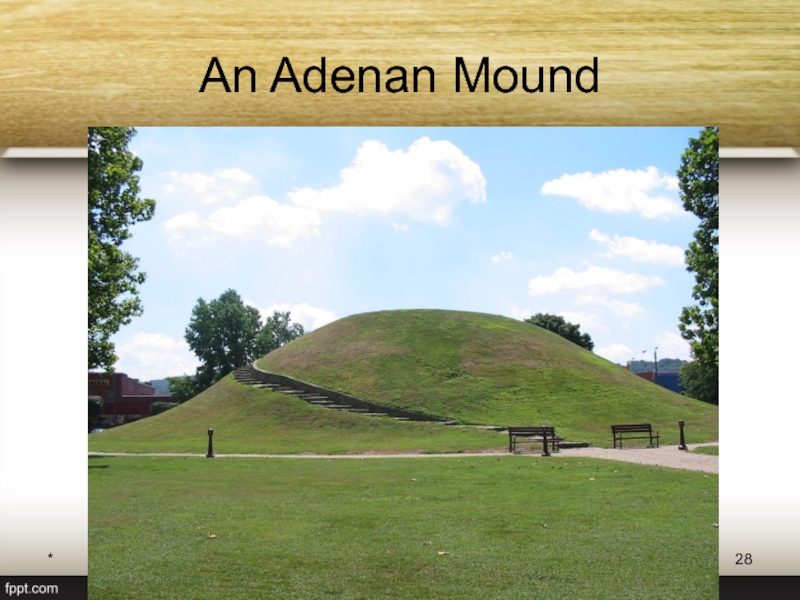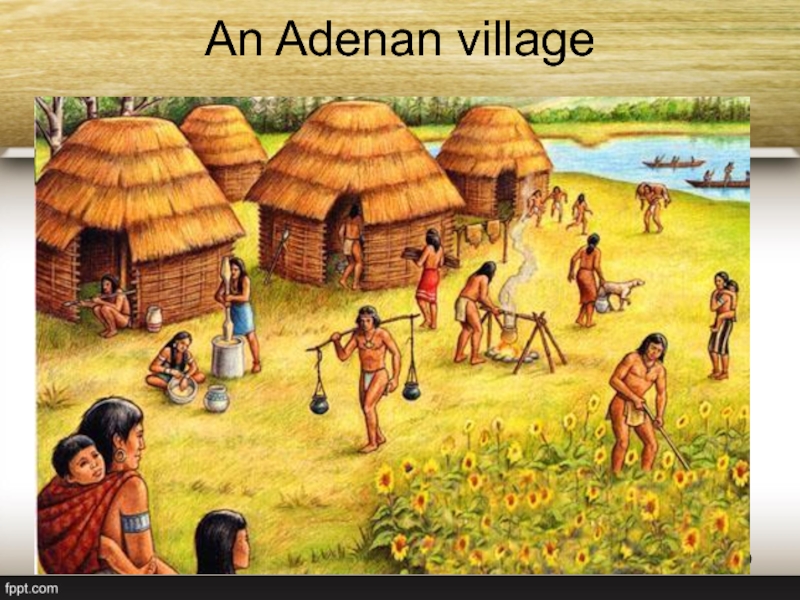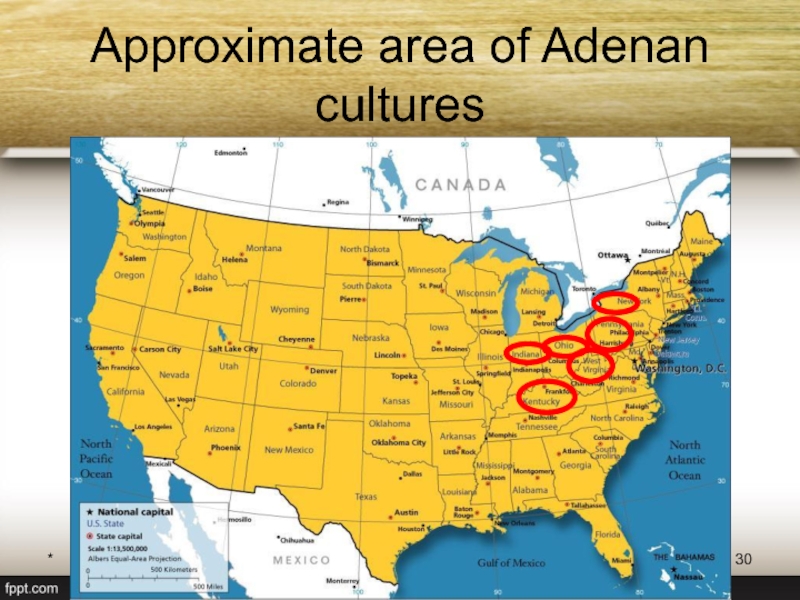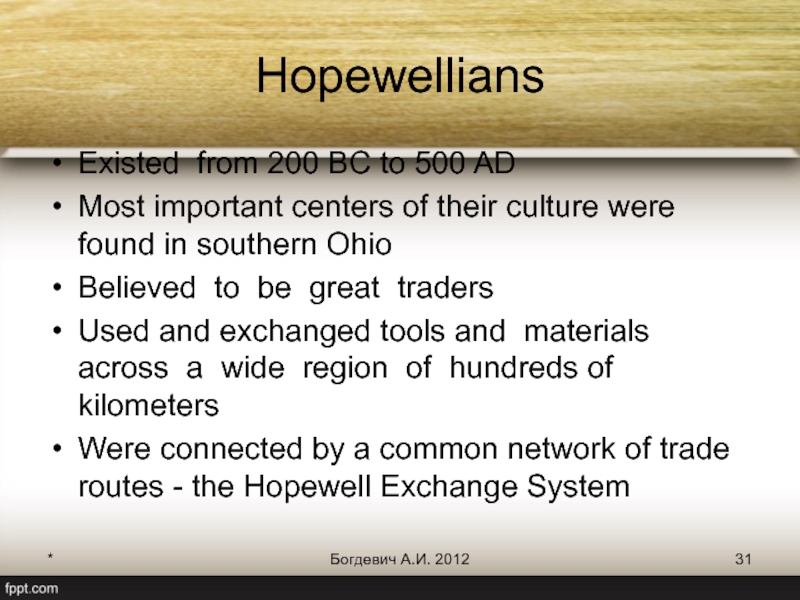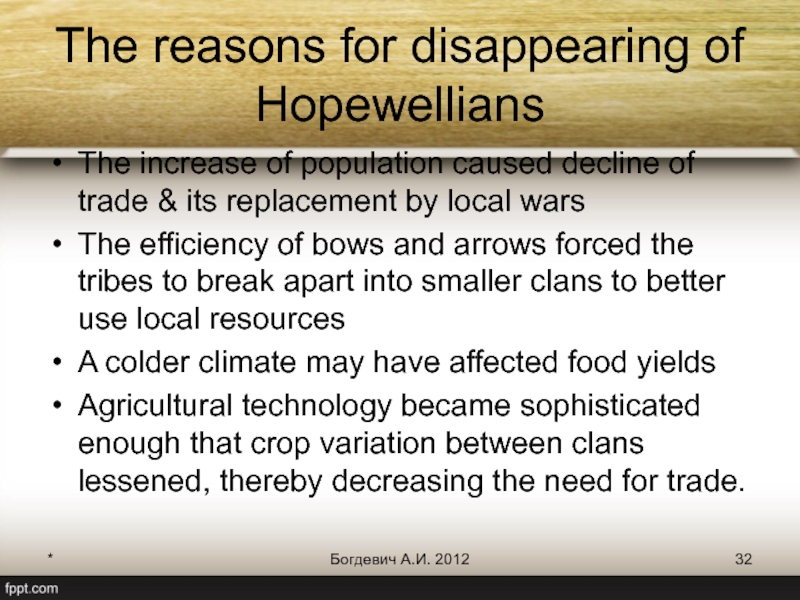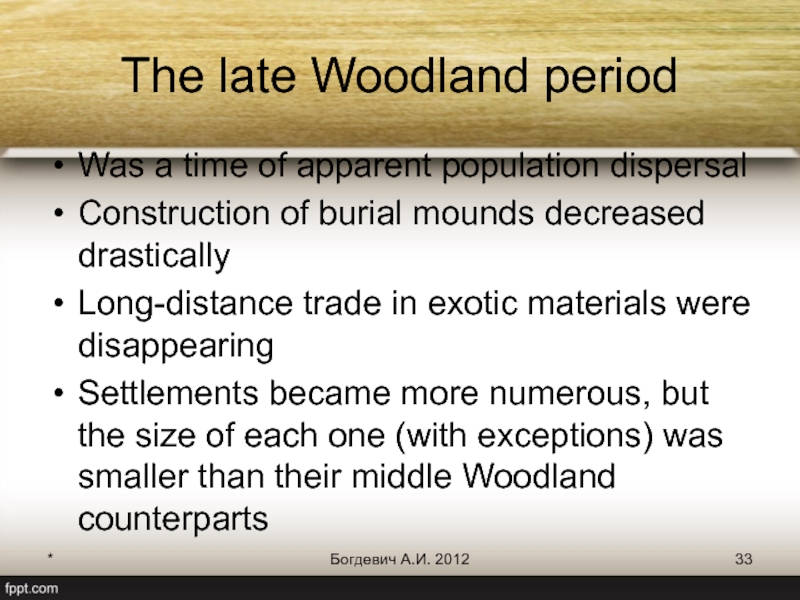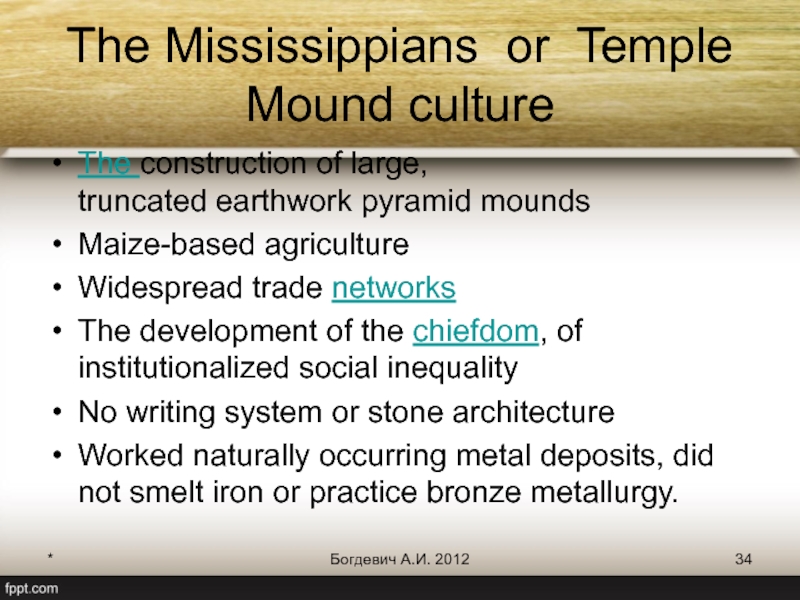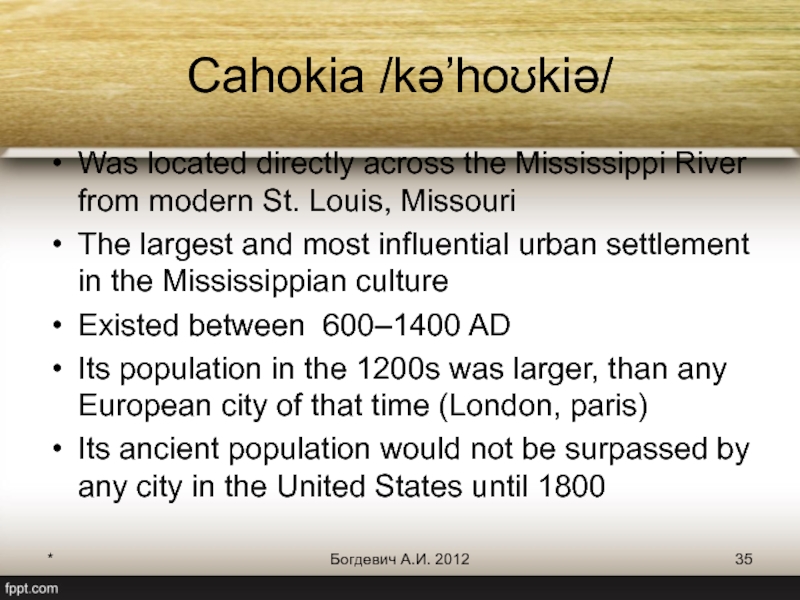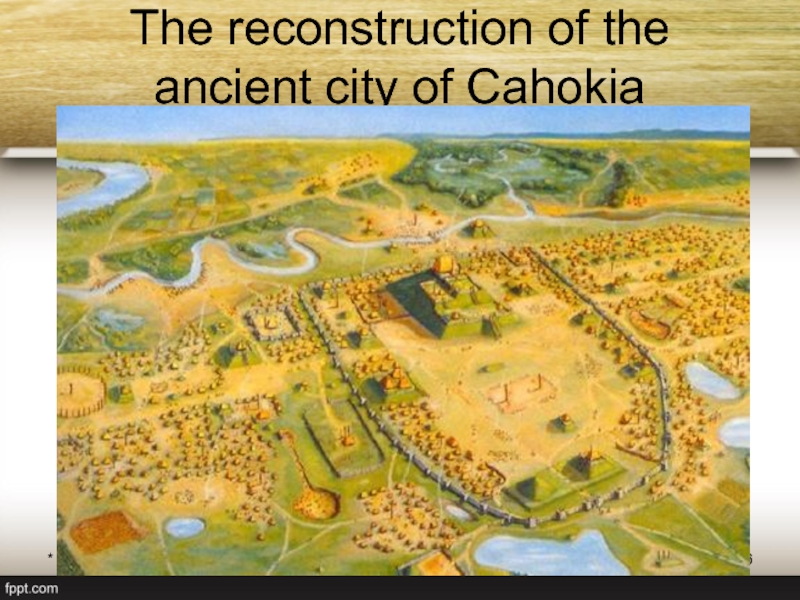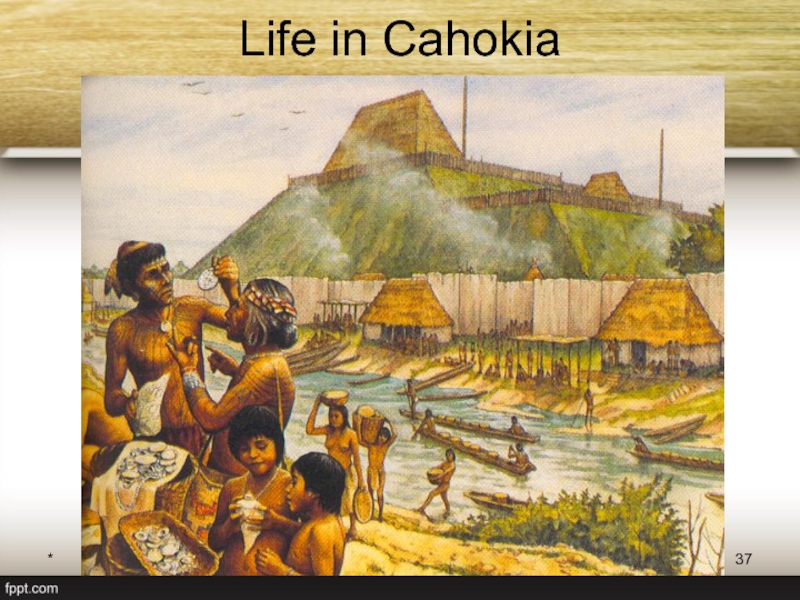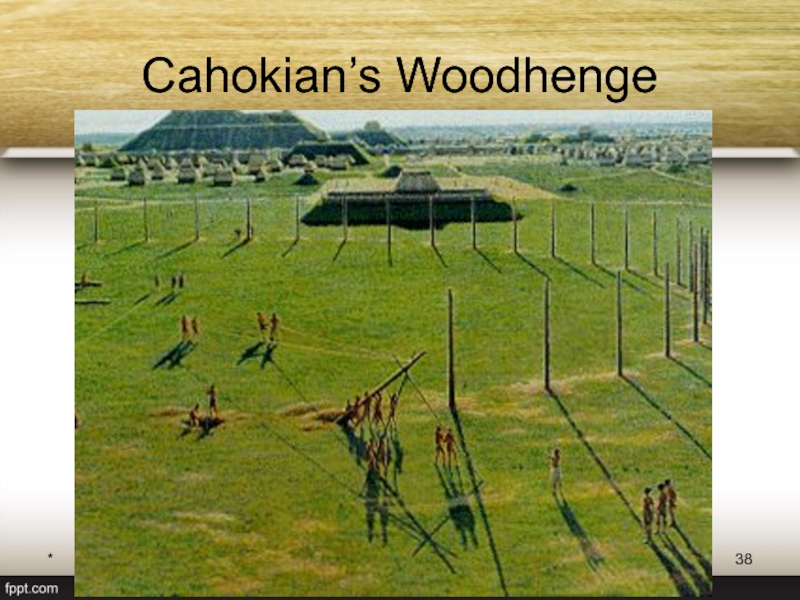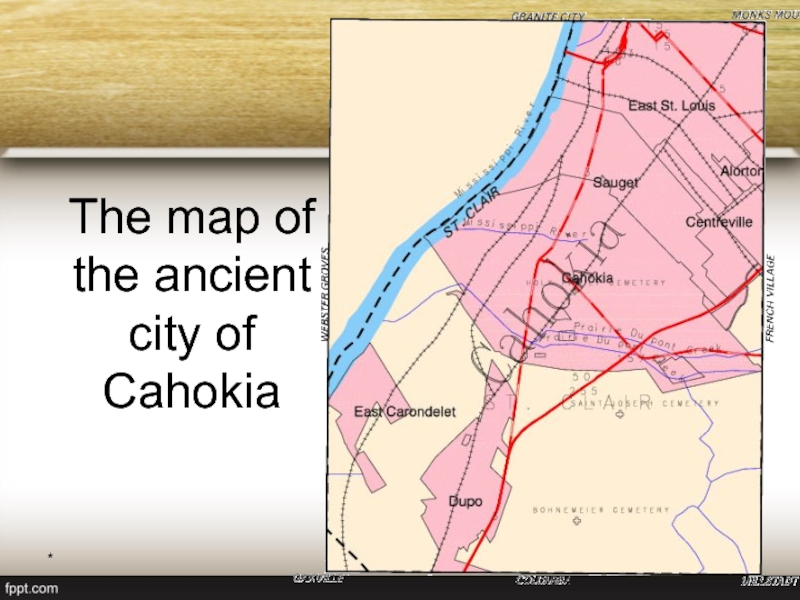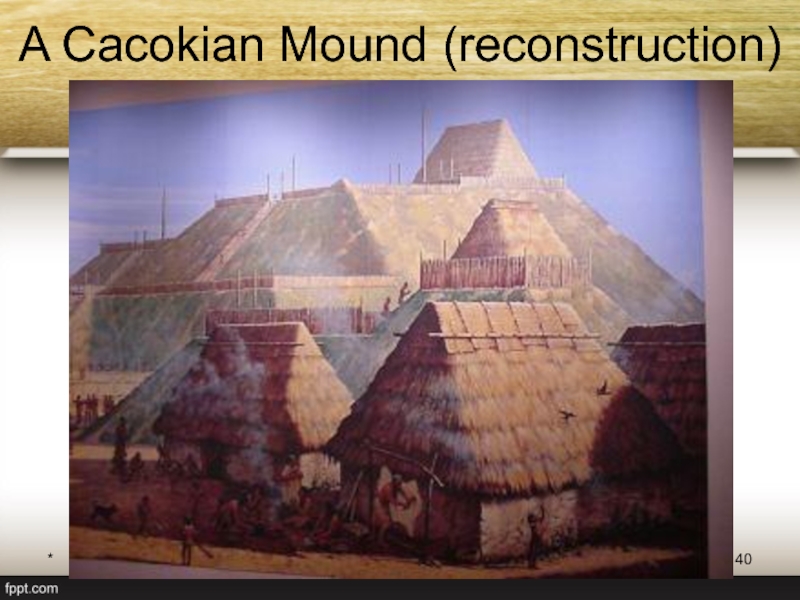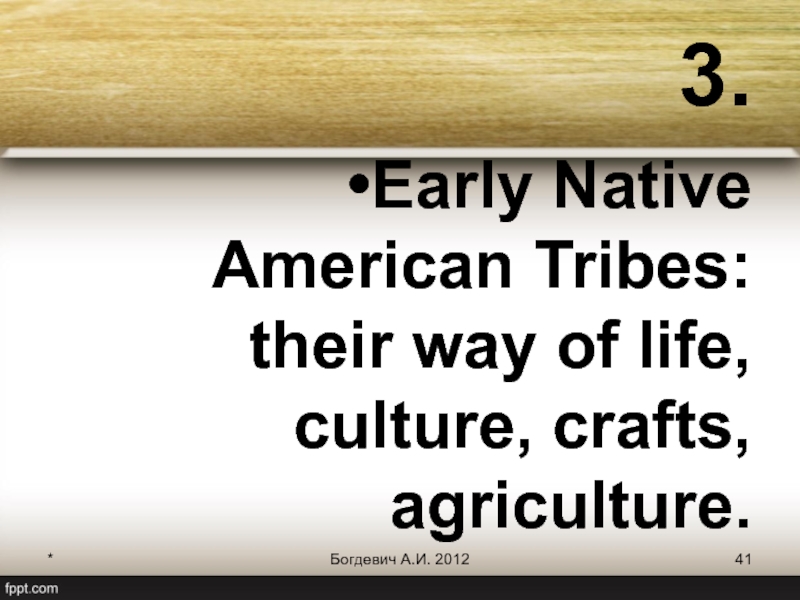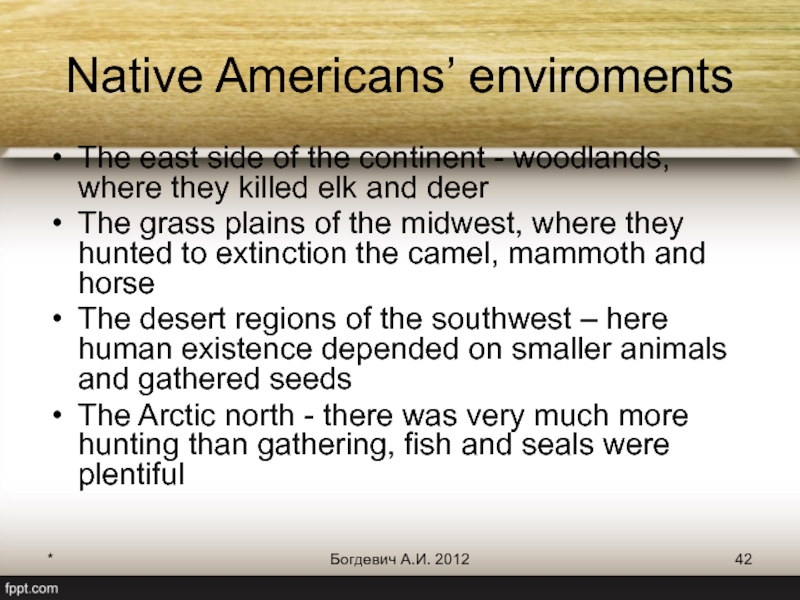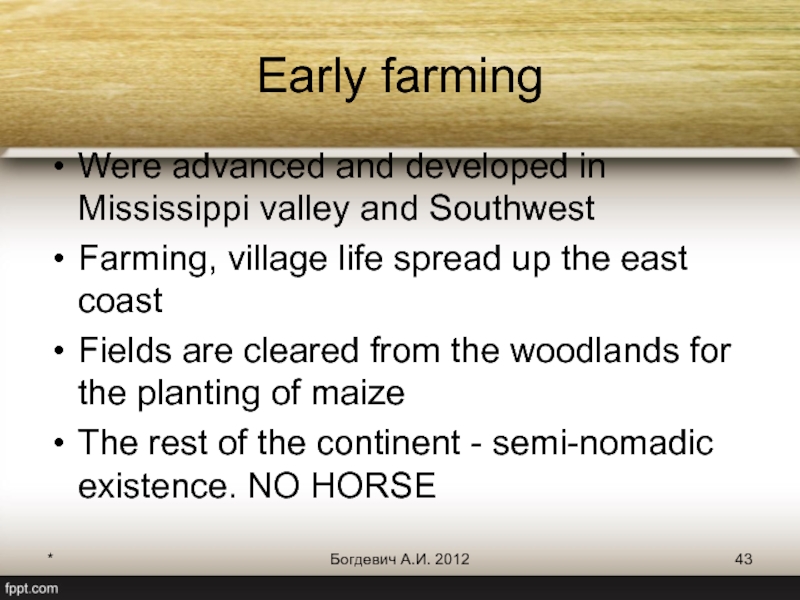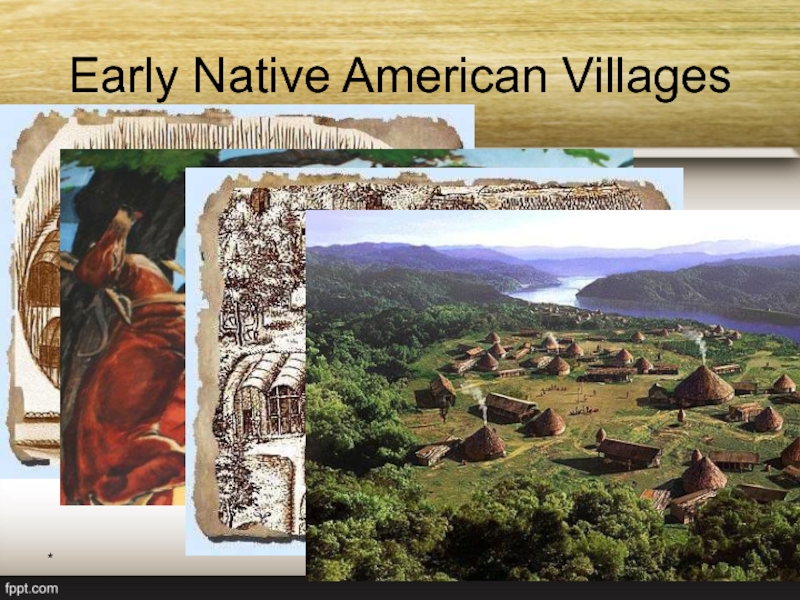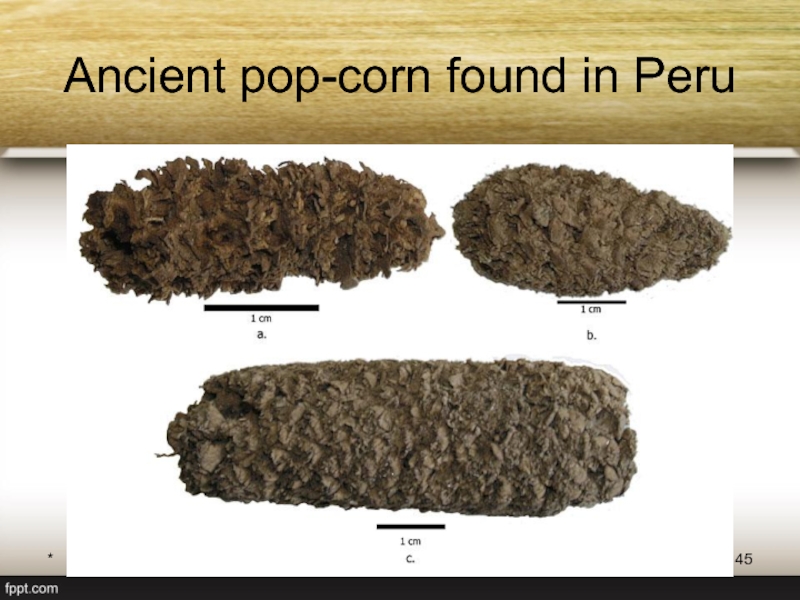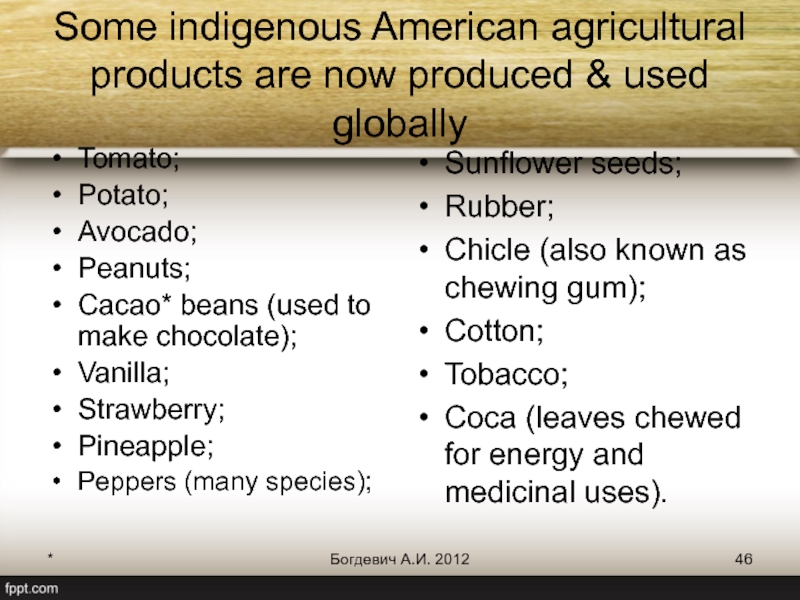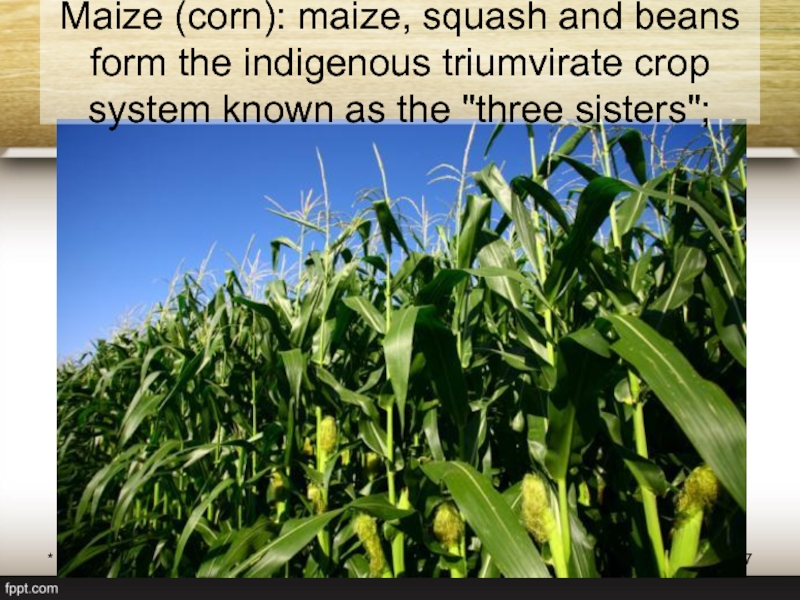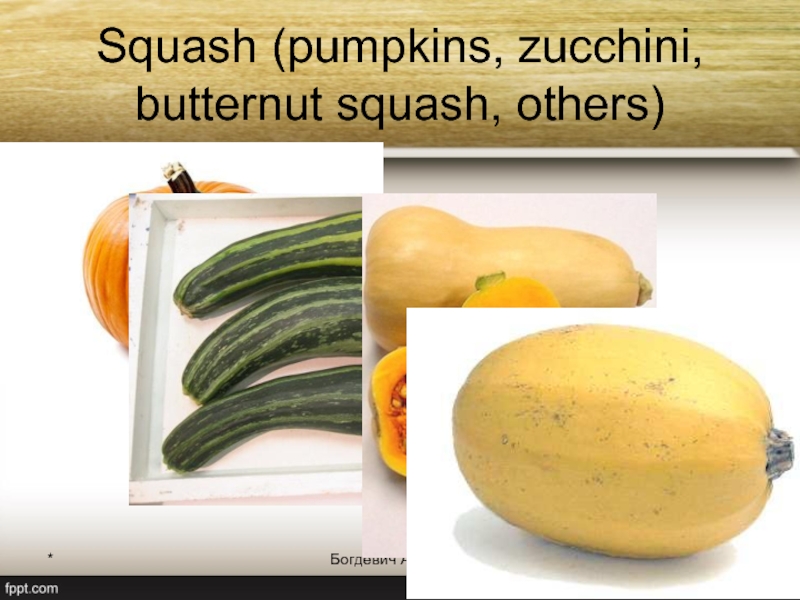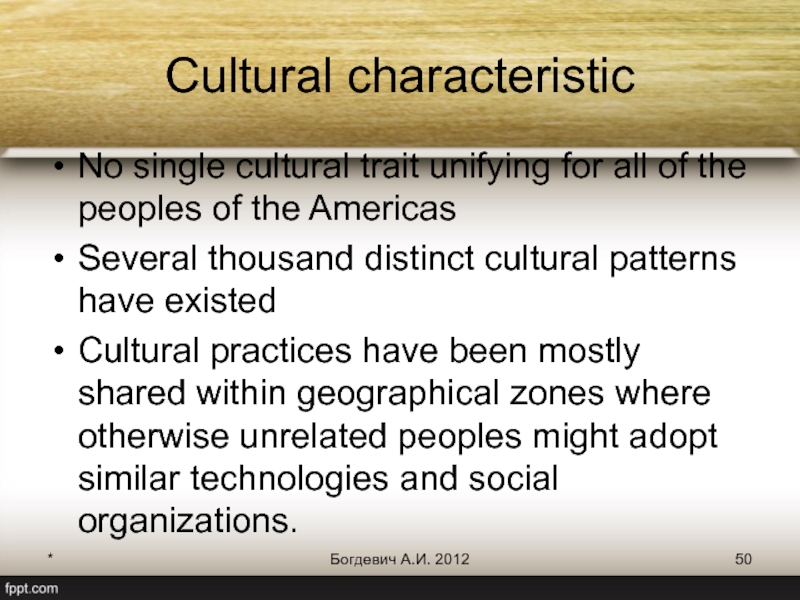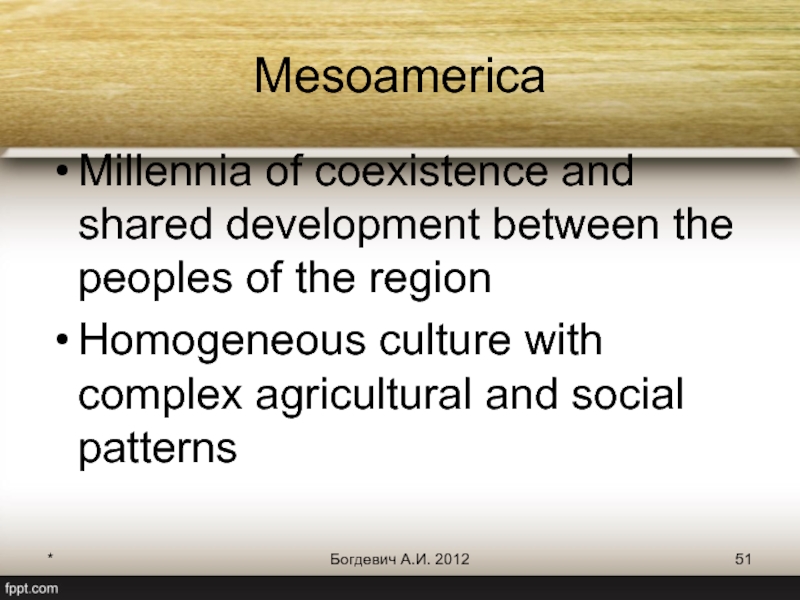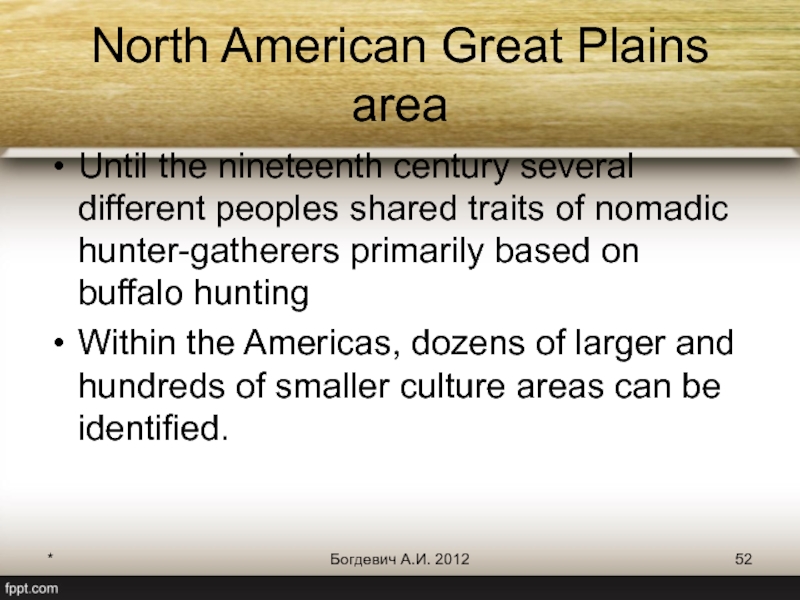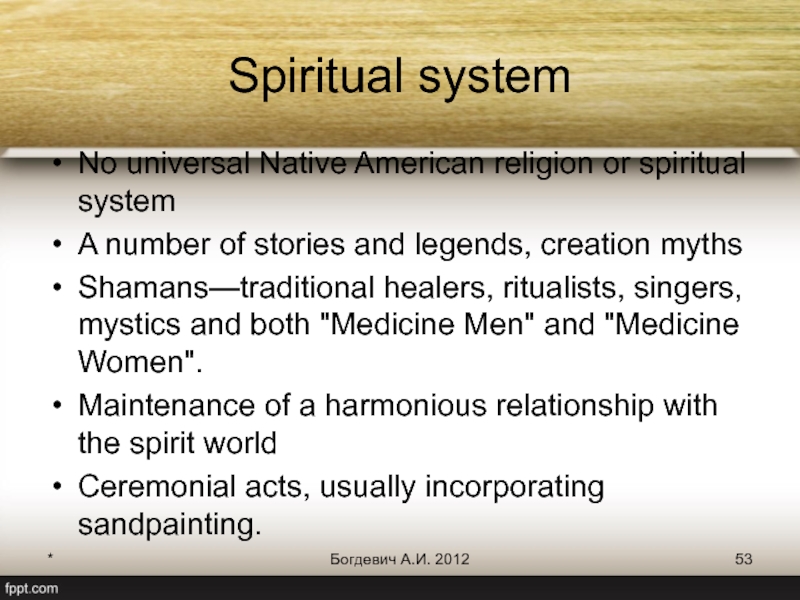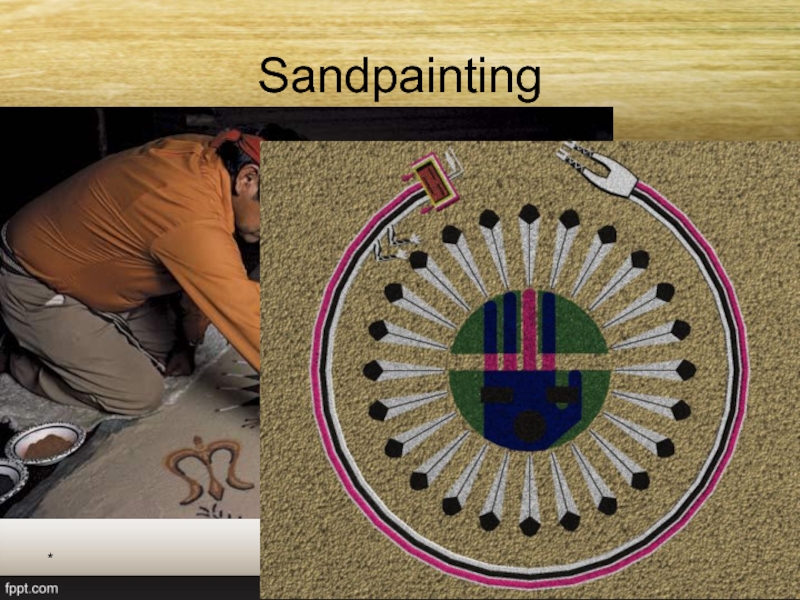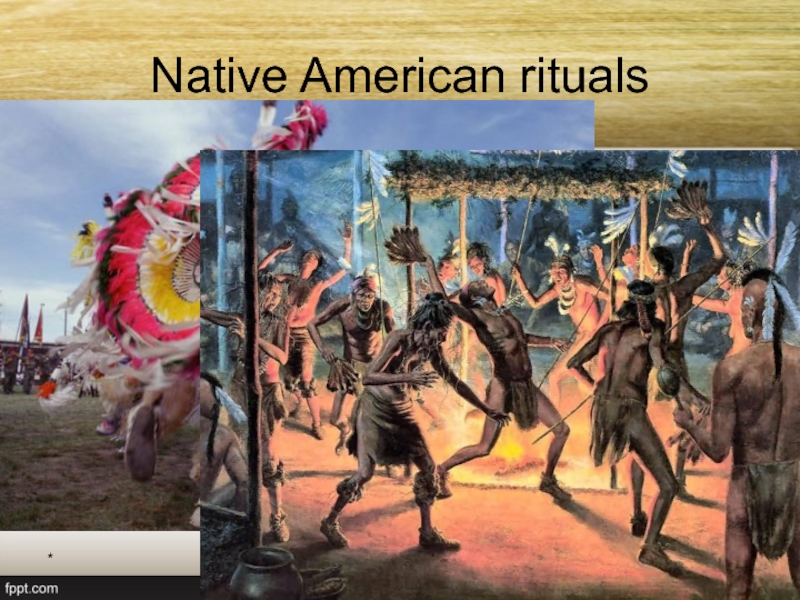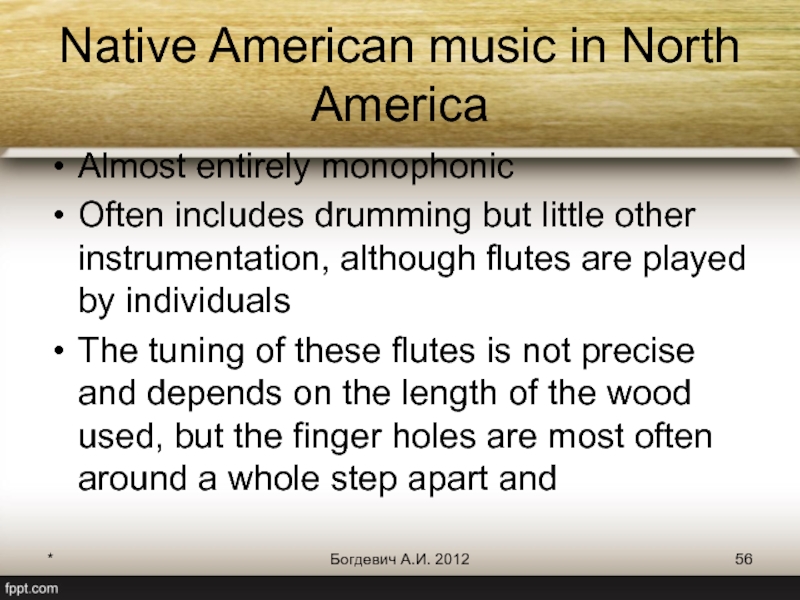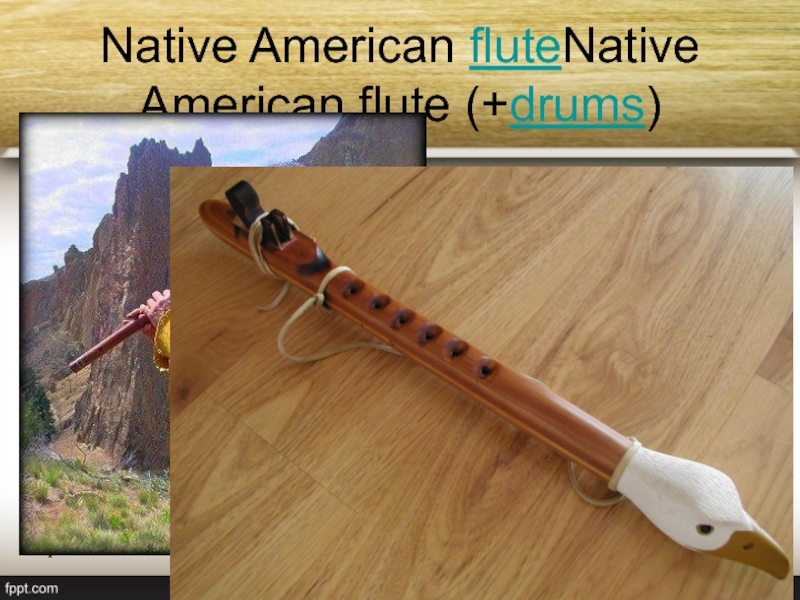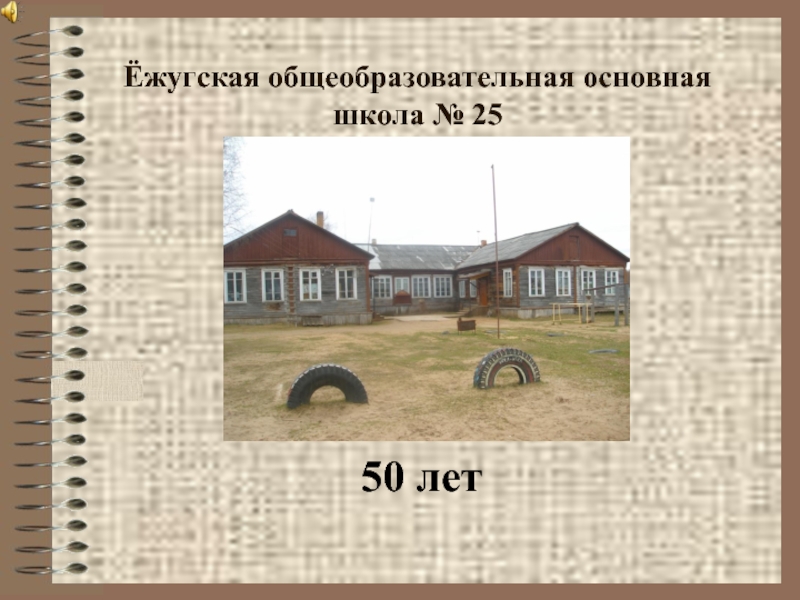- Главная
- Разное
- Дизайн
- Бизнес и предпринимательство
- Аналитика
- Образование
- Развлечения
- Красота и здоровье
- Финансы
- Государство
- Путешествия
- Спорт
- Недвижимость
- Армия
- Графика
- Культурология
- Еда и кулинария
- Лингвистика
- Английский язык
- Астрономия
- Алгебра
- Биология
- География
- Детские презентации
- Информатика
- История
- Литература
- Маркетинг
- Математика
- Медицина
- Менеджмент
- Музыка
- МХК
- Немецкий язык
- ОБЖ
- Обществознание
- Окружающий мир
- Педагогика
- Русский язык
- Технология
- Физика
- Философия
- Химия
- Шаблоны, картинки для презентаций
- Экология
- Экономика
- Юриспруденция
Pre-Columbian America презентация
Содержание
- 1. Pre-Columbian America
- 2. * Богдевич А.И. 2012 1. The first Americans
- 3. * Богдевич А.И. 2012 Theories of the
- 4. * Богдевич А.И. 2012 The short chronology
- 5. * Богдевич А.И. 2012 The long chronology
- 6. * Богдевич А.И. 2012 Theories of the
- 7. * Богдевич А.И. 2012 The land bridge
- 8. * Богдевич А.И. 2012 Beringia Existed at
- 9. * Богдевич А.И. 2012 Beringia
- 10. * Богдевич А.И. 2012 First people Came
- 11. * Богдевич А.И. 2012 Migration of the first people to Americas
- 12. * Богдевич А.И. 2012 Current understanding of
- 13. * Богдевич А.И. 2012 The two main
- 14. * Богдевич А.И. 2012 The coastal (watercraft)
- 15. * Богдевич А.И. 2012 Watercraft subtheories People
- 16. * Богдевич А.И. 2012 Atlantic route hypothesis
- 17. * Богдевич А.И. 2012 Who were the
- 18. * Богдевич А.И. 2012 The hypothetical Altai homeland of the American population
- 19. * Богдевич А.И. 2012 2. The Ancient Population of the North America
- 20. * Богдевич А.И. 2012 Evidence of early
- 21. * Богдевич А.И. 2012 The Timeline of
- 22. * Богдевич А.И. 2012 Paleo-Indian Period
- 23. * Богдевич А.И. 2012 Early changes in
- 24. * Богдевич А.И. 2012 The spread of
- 25. * Богдевич А.И. 2012 Archaic period is
- 26. * Богдевич А.И. 2012 Early Woodland period
- 27. * Богдевич А.И. 2012 Early population of
- 28. * Богдевич А.И. 2012 An Adenan Mound
- 29. * Богдевич А.И. 2012 An Adenan village
- 30. * Богдевич А.И. 2012 Approximate area of Adenan cultures
- 31. * Богдевич А.И. 2012 Hopewellians Existed from
- 32. * Богдевич А.И. 2012 The reasons for
- 33. * Богдевич А.И. 2012 The late Woodland
- 34. * Богдевич А.И. 2012 The Mississippians or
- 35. * Богдевич А.И. 2012 Cahokia /kə’hoʊkiə/ Was
- 36. * Богдевич А.И. 2012 The reconstruction of the ancient city of Cahokia
- 37. * Богдевич А.И. 2012 Life in Cahokia
- 38. * Богдевич А.И. 2012 Cahokian’s Woodhenge
- 39. * Богдевич А.И. 2012 The map of the ancient city of Cahokia
- 40. * Богдевич А.И. 2012 A Cacokian Mound (reconstruction)
- 41. * Богдевич А.И. 2012 3. Early Native
- 42. * Богдевич А.И. 2012 Native Americans’ enviroments
- 43. * Богдевич А.И. 2012 Early farming Were
- 44. * Богдевич А.И. 2012 Early Native American Villages
- 45. * Богдевич А.И. 2012 Ancient pop-corn found in Peru
- 46. Some indigenous American agricultural products are now
- 47. * Богдевич А.И. 2012 Maize (corn): maize,
- 48. * Богдевич А.И. 2012 Squash (pumpkins, zucchini, butternut squash, others)
- 49. Pinto bean (Frijol pinto) ("painted/speckled" bean; nitrogen-fixer
- 50. Cultural characteristic No single cultural trait
- 51. Mesoamerica Millennia of coexistence and shared development
- 52. North American Great Plains area Until the
- 53. Spiritual system No universal Native American religion
- 54. Sandpainting * Богдевич А.И. 2012
- 55. Native American rituals * Богдевич А.И. 2012
- 56. Native American music in North America Almost
- 57. Native American fluteNative American flute (+drums) * Богдевич А.И. 2012
Слайд 3*
Богдевич А.И. 2012
Theories of the settlement of America
Chronological approaches:
The short
The long chronology theory
Слайд 4*
Богдевич А.И. 2012
The short chronology theory
The first movement beyond Alaska into
It was followed by successive waves of immigrants
Слайд 5*
Богдевич А.И. 2012
The long chronology theory
The first group of people
Much later there was a mass secondary wave of immigrants
Слайд 6*
Богдевич А.И. 2012
Theories of the settlement of America
Chronological approaches:
The short
The long chronology theory
Route models
Land bridge theory
Coastal, or “watercraft” theory
Слайд 7*
Богдевич А.И. 2012
The land bridge theory
Also known as the Bering Strait
Has been widely accepted since the 1930s
Proposes that people migrated from Siberia into Alaska, tracking big game animal herds
Big game hunters crossed the Bering Strait at least 12,000 years ago and could have eventually reached the southern tip of South America by 11,000 years ago
Слайд 8*
Богдевич А.И. 2012
Beringia
Existed at the height of the Ice Age, between
A land bridge up to 1,500 km wide
A moist and treeless tundra, covered with grasses and plant life, attracting the large animals
Слайд 10*
Богдевич А.И. 2012
First people
Came to Americas through Beringia
They were isolated there
During the Late Glacial Maximum as the American glaciers blocking the way southward melted, these people began expanding to populate the Americas
Слайд 12*
Богдевич А.И. 2012
Current understanding of human migration to and throughout the
Archeology
Physical anthropology
DNA analysis
Linguistics.
Explain, what all these
branches of science
deal with
Слайд 13*
Богдевич А.И. 2012
The two main possible routes for “Beringian” people:
Down the
By way of an interior passage (Mackenzie Corridor) along the eastern flank of the Rocky Mountains
Слайд 14*
Богдевич А.И. 2012
The coastal (watercraft) theory
People reached the Americas via water
It’s not exclusive of land-based migrations
Helps to explain how early colonists reached areas extremely distant from the Bering Strait region (Monte Verde in southern Chile and Taima-Taima in western Venezuela)
Слайд 15*
Богдевич А.И. 2012
Watercraft subtheories
People in boats followed the coastline from the
Atlantic route hypothesis:
based on evidence which traces the origins to the a culture of Ice Age Western Europe
Ice Age Europeans migrated to North America by using skills similar to those possessed by the modern Eskimo-Aleut peoples and followed the edge of the ice sheet that spanned the Atlantic
is not largely accepted in the scientific world
Слайд 17*
Богдевич А.И. 2012
Who were the first Americans?
Common belief: descendants from northeast
New idea, based on new evidence: Southeast Asians (partly)
Atlantic route hypothesis: Europeans (no DNA evidence)
Most modern research (January 2012): descendants from Altai (Russia)
Слайд 20*
Богдевич А.И. 2012
Evidence of early life in North America
Little of it
A recent discovery of a hunting look-out in northern Alaska may date from that time
The finely crafted spear points and items found near Clovis, New Mexico, etc. (throughout North and South America)
SUMMARY: life was probably already well established in much of the Western Hemisphere by some time prior to 10,000 B.C.
Слайд 21*
Богдевич А.И. 2012
The Timeline of Early American History
Paleo-Indian Period (18,000 BC
Archaic Period (8000 BC - 1000 BC)
Early Woodland Period (1000 - 1 BC)
Middle Woodland Period (1–500 CE)
Late Woodland Period (500–1000 CE)
Mississippian cultures (1000 – 1500 СЕ)
Слайд 22*
Богдевич А.И. 2012
Paleo-Indian Period
Early Paleoamericans soon spread throughout the Americas
They
Their population was presented by small, highly mobile bands consisting of approximately 20 to 50 members of an extended family
They moved from place to place as preferred resources were depleted and new supplies were sought
Were efficient hunters and carried a variety of tools
Слайд 23*
Богдевич А.И. 2012
Early changes in life
The mammoth began to die out
More and more species of large game vanished from overhunting or natural causes
Plants, berries, and seeds became an increasingly important part of the early American diet
Foraging and the first attempts at primitive agriculture appeared
Слайд 24*
Богдевич А.И. 2012
The spread of early civilization
At about 8,000 B.C. native
By 3,000 B.C., a primitive type of corn was being grown in the river valleys of New Mexico and Arizona
Then the first signs of irrigation began to appear
By 300 B.C., signs of early village life appear
Слайд 25*
Богдевич А.И. 2012
Archaic period
is characterized by subsistence economies supported through the
multi-family dwellings in villages, which were used seasonally
societies of hunter-gatherers
Native American tribes traded with other tribes located in different regions
Слайд 26*
Богдевич А.И. 2012
Early Woodland period (1000–1 BC)
Pottery and ceramic making are
Appearance of permanent settlements
Elaborate burial practices
Intensive collection growing of seed plants
Differentiation in social organization, and specialized activities
Слайд 27*
Богдевич А.И. 2012
Early population of the USA territory
The first Native-American group
Began constructing earthen burial sites and fortifications around 600 B.C.
Area: Ohio, Indiana, West Virginia, Kentucky, and parts of Pennsylvania and New York
Appear to have been absorbed or displaced by various groups collectively known as Hopewellians.
Слайд 31*
Богдевич А.И. 2012
Hopewellians
Existed from 200 BC to 500 AD
Most important centers of their culture
Believed to be great traders
Used and exchanged tools and materials across a wide region of hundreds of kilometers
Were connected by a common network of trade routes - the Hopewell Exchange System
Слайд 32*
Богдевич А.И. 2012
The reasons for disappearing of Hopewellians
The increase of population
The efficiency of bows and arrows forced the tribes to break apart into smaller clans to better use local resources
A colder climate may have affected food yields
Agricultural technology became sophisticated enough that crop variation between clans lessened, thereby decreasing the need for trade.
Слайд 33*
Богдевич А.И. 2012
The late Woodland period
Was a time of apparent population
Construction of burial mounds decreased drastically
Long-distance trade in exotic materials were disappearing
Settlements became more numerous, but the size of each one (with exceptions) was smaller than their middle Woodland counterparts
Слайд 34*
Богдевич А.И. 2012
The Mississippians or Temple Mound culture
The construction of large,
Maize-based agriculture
Widespread trade networks
The development of the chiefdom, of institutionalized social inequality
No writing system or stone architecture
Worked naturally occurring metal deposits, did not smelt iron or practice bronze metallurgy.
Слайд 35*
Богдевич А.И. 2012
Cahokia /kə’hoʊkiə/
Was located directly across the Mississippi River from
The largest and most influential urban settlement in the Mississippian culture
Existed between 600–1400 AD
Its population in the 1200s was larger, than any European city of that time (London, paris)
Its ancient population would not be surpassed by any city in the United States until 1800
Слайд 41*
Богдевич А.И. 2012
3.
Early Native American Tribes: their way of life, culture,
Слайд 42*
Богдевич А.И. 2012
Native Americans’ enviroments
The east side of the continent -
The grass plains of the midwest, where they hunted to extinction the camel, mammoth and horse
The desert regions of the southwest – here human existence depended on smaller animals and gathered seeds
The Arctic north - there was very much more hunting than gathering, fish and seals were plentiful
Слайд 43*
Богдевич А.И. 2012
Early farming
Were advanced and developed in Mississippi valley and
Farming, village life spread up the east coast
Fields are cleared from the woodlands for the planting of maize
The rest of the continent - semi-nomadic existence. NO HORSE
Слайд 46Some indigenous American agricultural products are now produced & used globally
Tomato;
Potato;
Avocado;
Peanuts;
Cacao* beans (used to make chocolate);
Vanilla;
Strawberry;
Pineapple;
Peppers (many species);
Sunflower seeds;
Rubber;
Chicle (also known as chewing gum);
Cotton;
Tobacco;
Coca (leaves chewed for energy and medicinal uses).
*
Богдевич А.И. 2012
Слайд 47*
Богдевич А.И. 2012
Maize (corn): maize, squash and beans form the indigenous
Слайд 49Pinto bean (Frijol pinto) ("painted/speckled" bean; nitrogen-fixer traditionally planted in conjunction
*
Богдевич А.И. 2012
Слайд 50Cultural characteristic
No single cultural trait unifying for all of the
Several thousand distinct cultural patterns have existed
Cultural practices have been mostly shared within geographical zones where otherwise unrelated peoples might adopt similar technologies and social organizations.
*
Богдевич А.И. 2012
Слайд 51Mesoamerica
Millennia of coexistence and shared development between the peoples of the
Homogeneous culture with complex agricultural and social patterns
*
Богдевич А.И. 2012
Слайд 52North American Great Plains area
Until the nineteenth century several different peoples
Within the Americas, dozens of larger and hundreds of smaller culture areas can be identified.
*
Богдевич А.И. 2012
Слайд 53Spiritual system
No universal Native American religion or spiritual system
A number of
Shamans—traditional healers, ritualists, singers, mystics and both "Medicine Men" and "Medicine Women".
Maintenance of a harmonious relationship with the spirit world
Ceremonial acts, usually incorporating sandpainting.
*
Богдевич А.И. 2012
Слайд 56Native American music in North America
Almost entirely monophonic
Often includes drumming but
The tuning of these flutes is not precise and depends on the length of the wood used, but the finger holes are most often around a whole step apart and
*
Богдевич А.И. 2012
